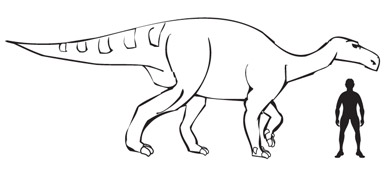Road Builders Uncover Rare Dinosaur Trackway
Road Builders in Peru Discover Fossils
Peruvian construction workers have uncovered an array of body and trace fossils dating back to the age of the dinosaurs as they worked on a new road, one of the discoveries is a dinosaur trackway. As well as dinosaur fossils, including some really well preserved footprints, the road workers found fossils of crocodiles, pterosaurs, primitive tortoises and remains of extinct species of fish.
Palaeontologists who have been called in to study the site have revealed that the remains of at least a dozen animals have been found, the sediments date back to the Early Cretaceous and have been dated to approximately 120 million years ago (Aptian faunal stage).
Dinosaur Trackway
Pictures show a set of four footprints, the prints have three prominent toes and the animal was walking from right to left as you look at the photographs. Such prints are known as trace fossils. Trace fossils preserve evidence of the activity of organisms, such as their tracks, trails, burrows or borings. As these type of fossils are not subject to be moved by natural forces, as in the case of dinosaur bones for example, where an animal’s carcase can be moved a long way from where it died to where the body finally comes to rest and is fossilised, trace fossils are direct in situ evidence of the environment at the time and place the fossils were formed.
Unfortunately, as with most photographs of this type, there is nothing in the picture to give scale. However, it does look like these particular prints were made by herbivorous ornithopod dinosaurs, perhaps something from the Iguanodontidae or a member of the Hypsilophodontidae.
These types of animals were relatively common during this part of the Cretaceous. Iguanodontids have been associated with Australia, Asia, Europe, the UK and Africa. Iguanodon for example, was one of the first dinosaurs to be scientifically described, although the taxon is currently under review.
Typical Ornithopods
Iguanodontids are typical ornithopods, with beaks, narrow mouths and banks of grinding teeth. Most of these dinosaurs were heavily built quadrupeds, but also capable of walking on their hind legs. The digits of the hands of the forelimbs were specialised and modified. The thumb for example (digit one), was a large spike, probably used for defence. The long, deep tail helped balance the animal as it walked.
An Illustration of Iguanodon

Picture credit: Everything Dinosaur
To see a model of Iguanodon and other ornithopod dinosaurs: Dinosaur and Prehistoric Animal Models.
Studying Dinosaur Tracks
By studying trackways, scientists can gain an appreciation of animal behaviour. For example, if several tracks of a single species are preserved, all heading in the same direction this may indicate herding behaviour. The velocity of the animal that made the tracks can be calculated using a formula and measuring the stride length and other items related to the leg speed of the animal.
The fossil site is located in the Ancash region of central Peru, approximately 250 miles north-east of Lima. At a height of over 4,600 metres above sea level, this fossil dig site is believed to be one of the highest prehistoric fossil sites found to date.

